Patents
The Advertising Chair
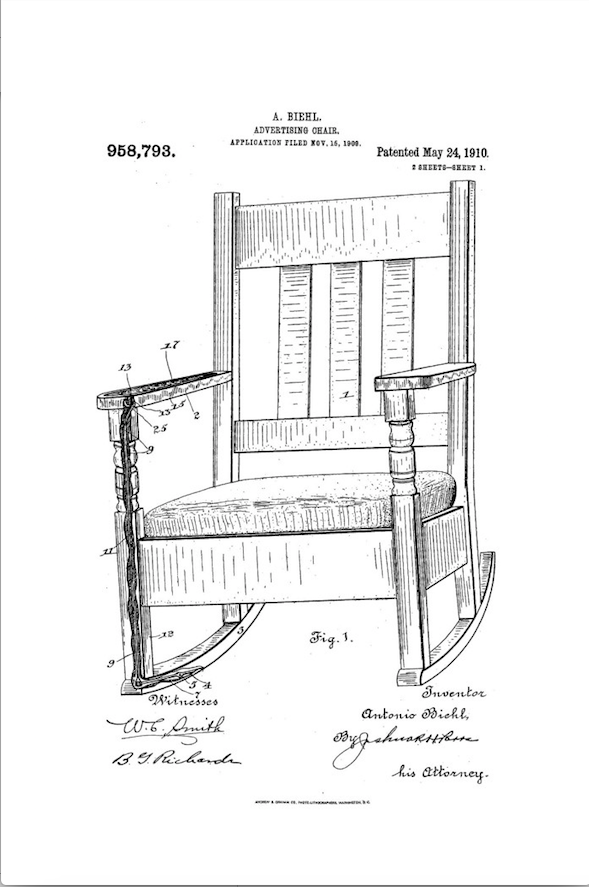
When the chair rocked, visible adverts scrolled in the arms of the chair. So much for our age having a monopoly on intrusive ads.
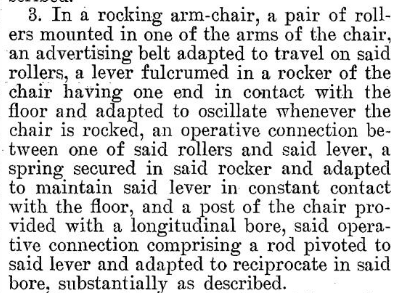
Complete patent here.
Posted By: Paul - Wed Sep 12, 2018 -
Comments (0)
Category: Inventions, Patents, Technology, Advertising, Interior Decorating, 1900s
Method of Preserving the Dead
Patented Dec 29, 1903 by Joseph Karwowski:In carrying out my process I first surround the corpse 1 with a thick layer 2 of sodium silicate or water-glass. After the corpse has been thus inclosed within the layer of waterglass it is allowed to remain for a short time within a compartment or chamber having a dry heated temperature, which will serve to evaporate the water from this incasing layer, after which molten glass is applied to the desired thickness. This outer lay of glass may be molded into a rectangular form 3, as shown in Fig. 2 of the drawings, or, if preferred, cylindrical or other forms may be substituted for the rectangular block which I have illustrated. In Fig. 3 I have shown the head only of the corpse as incased within the transparent block of glass, it being at once evident that the head alone may be preserved in this manner, if preferred.
It will be at once noted that a body preserved in this way may be kept indefinitely, as the body being hermetically inclosed within the outer glass covering it will be impossible for air to reach it, and hence it will be effectually preserved from decay. The glass surrounding the corpse being transparent, the body will be at all times visible.

Posted By: Alex - Fri Sep 07, 2018 -
Comments (6)
Category: Death, Inventions, Patents, 1900s
Cremation by solar power
Patent #US4781174A:Seems like something a James Bond villain would create, if he were in the funeral business.


Posted By: Alex - Mon Jul 02, 2018 -
Comments (7)
Category: Death, Inventions, Patents, 1980s
Hat Guard
Back in the day when the theft of hats from hatracks was an ongoing problem, Frank P. Snow of Los Angeles patented this invention designed to inflict pain on any would-be hat thieves.A thief could take the hat, but if he tried to put it on, a "guarding prong" would jab into his skull. The prong locked in place and could only be moved if you knew the code to the combination lock.

Official Gazette of the United States Patent Office - June 2, 1914
Posted By: Alex - Thu Jun 14, 2018 -
Comments (2)
Category: Inventions, Patents, Headgear, 1910s
Open Zipper Alarm
US Patent Application No. 2009/0195400A1 describes an invention that can "provide a warning or alert regarding the position of the zipper."Sounds potentially useful. What kind of warning does it give you? Apparently you've got a choice of a sound, vibration, having a page sent to a remote device, or getting an electric shock.

Posted By: Alex - Sat Jun 09, 2018 -
Comments (5)
Category: Inventions, Patents
Inflatable Coffin
Patented by Clifford Malbon of Daytona Beach, Florida in 1977. Patent # US4050125A. From the patent abstract: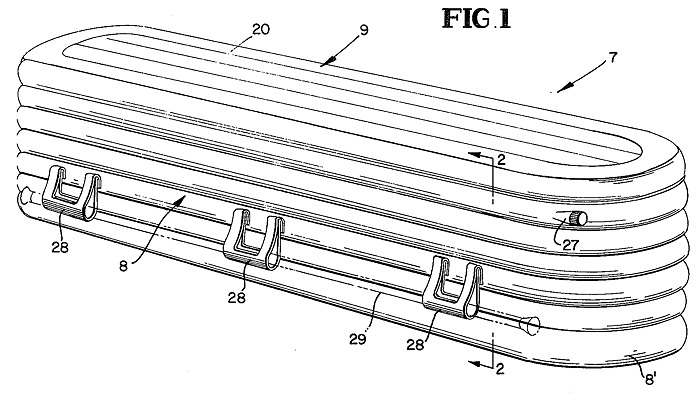
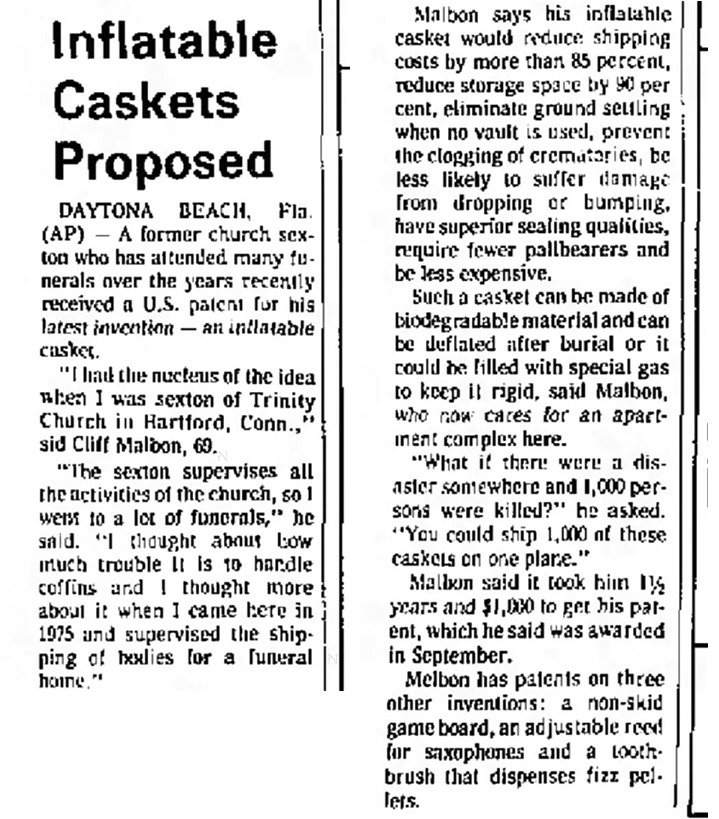
Naples Daily News - Dec 11, 1977
Posted By: Alex - Fri Jun 01, 2018 -
Comments (5)
Category: Death, Inventions, Patents, 1970s
Urinal Forehead Support
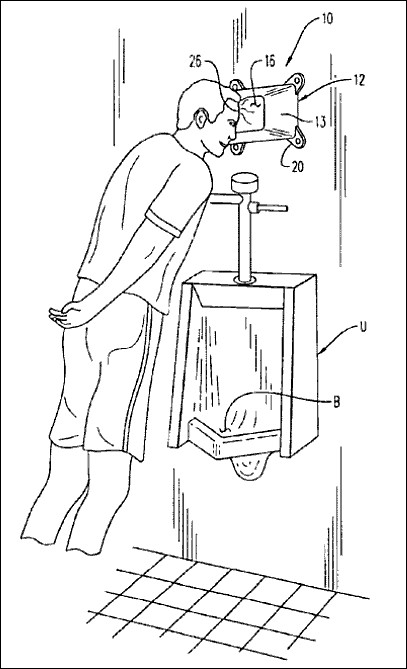
U.S. Patent No. 6,618,419.
Posted By: Alex - Tue Mar 06, 2018 -
Comments (8)
Category: Bathrooms, Inventions, Patents
Shed Defender
AKA leotards for dogs. Available at sheddefender.com.
Posted By: Alex - Tue Jan 09, 2018 -
Comments (3)
Category: Fashion, Patents, Dogs
Greenhouse Helmet
Patented in 1986 by Waldemar Anguita of Brooklyn, NY. And I'm not sure, but this may be Waldemar's Twitter account. After all, how many Waldemar Anguitas of approximately the right age can there be in Brooklyn?Another object is to provide a greenhouse helmet that has air filters so that ambient air containing carbon dioxide will be filtered therethrough and mixed with the carbon dioxide breathed out by the person to be used by the plants.
An additional object is to provide a greenhouse helmet that will contain hearing and speaking devices so that the person can hear within and speak out through the helmet.
A further object is to provide a greenhouse helmet that is economical in cost to manufacture.
A still further object is to provide a greenhouse helmet that is simple and easy to use.

Posted By: Alex - Wed Dec 27, 2017 -
Comments (3)
Category: Inventions, Patents, 1980s
Atomic Bomb Car
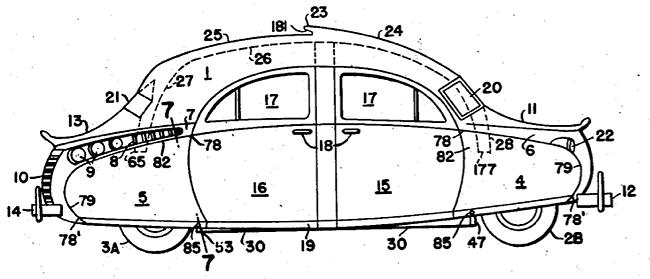
In 1953, Corwin D. Willson of Flint, Michigan patented the Atomic Bomb Car. Though the official title on the patent was a "sedan having versatile structure."
His idea was that if the United States were "atomically attacked," people would need to flee the cities, and then they'd have to live in their cars. But most cars aren't designed to be lived in. The solution: turn cars into mobile bomb shelters that could provide temporary housing for people. Essentially, he was patenting a camper car, but he was trying to market it as a defense against atomic attack.
From the patent:
And also:
More info: JF Ptak Science Books, Patent #US2638374A
Posted By: Alex - Mon Mar 27, 2017 -
Comments (1)
Category: Inventions, Patents, Atomic Power and Other Nuclear Matters, 1950s

| Who We Are |
|---|
| Alex Boese Alex is the creator and curator of the Museum of Hoaxes. He's also the author of various weird, non-fiction, science-themed books such as Elephants on Acid and Psychedelic Apes. Paul Di Filippo Paul has been paid to put weird ideas into fictional form for over thirty years, in his career as a noted science fiction writer. He has recently begun blogging on many curious topics with three fellow writers at The Inferior 4+1. Contact Us |




